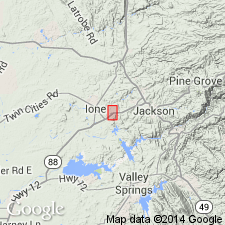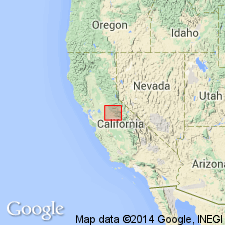
- Usage in publication:
-
- Newton Mine volcanics*
- Modifications:
-
- Named
- Dominant lithology:
-
- Schist
- Tuff
- Slate
- AAPG geologic province:
-
- Sierra Nevada province
Summary:
Pg. 51, 52, 53, pl. 7. Series of schists and greenstone in Newton copper mine area (near Jackson, Amador County, California) tentatively correlated with the Jurassic Amador group described by Taliaferro, 1942 (GSA Bull., v. 53, no. 1), is subdivided into 4 formations (descending) Mountain Spring volcanics, Dufrene slate, Newton Mine volcanics, and Sunnybrook volcanics (all new). Newton Mine volcanics consist chiefly of pale-green chlorite schist with lesser amounts of pale-green, fine-grained, bedded, chloritic tuff, and blue-gray slate. Approximate thickness 752 feet. Features resembling distorted pillows (possibly flows) occur along Sutter Creek, and a wedge-shaped mass of metafelsite occurs in northern part of area. Measured section, along Mountain Spring Creek from Mariposa slate eastward, dips steeply to east; relation of beds to Mariposa slate suggests section is overturned, and is on west limb of an overturned anticline or its faulted equivalent. Overlies Sunnybrook volcanics; underlies Dufrene slate. Age is Jurassic, based on tentative assignment to Amador(?) group. Mapped in Newton Mine area (scale 1:400), chloritic tuff and metafelsite shown separately.
Named from exposures surrounding Newton mine (6 mi west of Jackson [Sutter Creek 15-min quadrangle] Amador Co., east-central CA). [No type designated] but measured section along Mountain Spring Creek is about 752 feet thick. [Newton mine is on south side of CA Highway 88, in SW/4 sec. 28, T. 6 N., R. 11 E., Lat. 38 deg. 20 min. 31 sec. N., Long. 120 deg. 53 min. 12 sec. W., Ione 7.5-min quadrangle, Amador Co., CA.]
Source: US geologic names lexicon (USGS Bull. 1200, p. 2736); GNU records (USGS DDS-6; Menlo GNULEX).

- Usage in publication:
-
- Newton Mine volcanics
- Modifications:
-
- Not used
- AAPG geologic province:
-
- Sierra Nevada province
Summary:
Rocks of Newton Mine volcanics tentatively correlated with Amador group by Heyl and Eric (1948, California Div. Mines Bull., no. 144, p. 52-53) are here reassigned to Copper Hill volcanics. He included the Penon Blanco in his southern type section of Amador group (Merced River section), although he was unable at that time to establish complete correlation with his northern type section (Cosumnes River section); he did not recognize existence of Bear Mountains fault zone at this latitude and included rocks of both western and central blocks within the Amador group. In this report, name Penon Blanco volcanics is applied to sequence of volcanic rocks that underlies Mariposa formation, from the south end of mapped area (see pl. 1) to a point west of town of Melones, and is excluded from Amador group (Amador restricted to the central block, Cosumnes River area).
[Author does not capitalize rank terms; however, units are considered formal.]
Source: Modified from GNU records (USGS DDS-6; Menlo GNULEX).
For more information, please contact Nancy Stamm, Geologic Names Committee Secretary.
Asterisk (*) indicates published by U.S. Geological Survey authors.
"No current usage" (†) implies that a name has been abandoned or has fallen into disuse. Former usage and, if known, replacement name given in parentheses ( ).
Slash (/) indicates name conflicts with nomenclatural guidelines (CSN, 1933; ACSN, 1961, 1970; NACSN, 1983, 2005, 2021). May be explained within brackets ([ ]).

